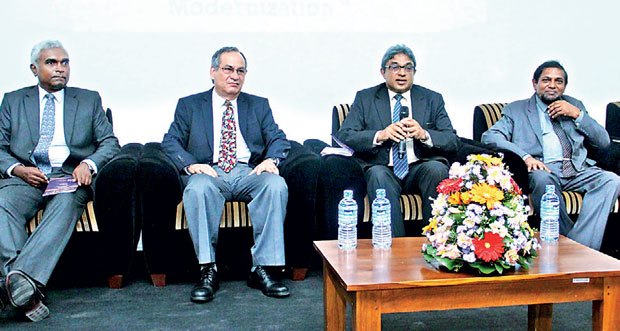Reply To:
Name - Reply Comment
 From Left: Energy Consultant Dr. Tilak Siyambalapitiya, Railway Electrification and Modernization Project of Sri Lanka Consultant Rodolfo Martinez, Moratuwa University Department of Transport & Logistics Professor Amal Kumarage and Railway Electrification and Modernization Project of Sri Lanka Project Director Palitha Samarasinghe
From Left: Energy Consultant Dr. Tilak Siyambalapitiya, Railway Electrification and Modernization Project of Sri Lanka Consultant Rodolfo Martinez, Moratuwa University Department of Transport & Logistics Professor Amal Kumarage and Railway Electrification and Modernization Project of Sri Lanka Project Director Palitha Samarasinghe
Pic by Damith Wickramasinghe
By Chandeepa Wettasinghe
The government could be following in the footsteps of its predecessors in project development, as the US$ 2 billion Colombo Suburban Railway Project aiming to modernize and electrify railroads under the grand Megapolis Plan has only taken into account an overly optimistic scenario, an expert warned.
The Megapolis plan expects the daily railroad demand to increase to 1.2 million passengers by 2025 and 1.4 million passengers by 2035, from the 300,000 figure recorded in 2016. A report is currently being authored to implement the rail upgrades.
“If you look at the numbers, the numbers are highly optimistic. We know that Megapolis numbers have not been validated,” University of Motaruwa Transport Department Professor Amal Kumarage said at a panel discussion of the John Diandas Memorial Lecture 2017 organized by the Chartered Institute of Logistics and Transport.
He said that the Megapolis project has based its projections off a study done several years ago when growth of demand for railroad had been high, and in the years since, the demand growth for it has been much lower.
Prof. Kumarage said that the Transport Ministry and the University of Moratuwa have much more up-to-date figures. He further noted that the railroad master plan has only taken into account this high growth possibility.
“When you are looking at growth, generally, the practice is to have low growth scenarios, high growth scenarios and all those stuff, at least. But it seems to me that only the high growth scenario has been used. So I think these are sensitivity factors which I feel, should be looked at,” he said.
Further Prof. Kumarage pointed out that the project should take into consideration the modernization and development of other modes of transport such as buses, which could divert demand from the railroads.
“That I think is the scientific way to go forward. Saying, ‘That is going to be done in another report’, is I think not the best arrangement, so I think that in the feasibility studies these things should be looked at. Because otherwise, we will have a recommendation to electrify all the railway tracks without actually having the sensitivity and the critical parametres that will make it work,” he said.
He stressed that he is not calling for modernization to not take place, but to be more realistic.
“This country has a lot of examples of putting capacity where we don’t need capacity and not putting capacity where we need capacity, so I think we should not continue in this same way,” he noted.
Railway Electrification and Modernization Project of Sri Lanka Consultant Rodolfo Martinez, who delivered the memorial lecture, replied to Prof. Kumarage, by saying that the plan is based on preference surveys from residents in the railroad corridors, who had said that they would travel by rail if there was capacity.
“Currently the numbers are not indicating the demand, because the service is not there, but the potential is there, if the service is provided,” he said.
Martinez also noted that if the entire system is upgraded, then the government can start by purchasing 50 percent of the trains that can be accommodated by the new system if the demand is low, and start scaling up.
“We need to plan for the whole system. We need to assume that the potential demand can be reached,” he said.
Both the experts however agreed that a key determinant of the future demand will be the pricing of the service, which the government has to decide whether to subsidize or not.
“Sensitivity of pricing could cut the current ridership by half. The government is saying that the railways are costing an x amount. It could become 2x or 3x, so the report needs to reflect this,” Prof. Kumarage said, but noted that cargo transport could bring in higher income for the Railway Department.
Martinez noted that the upgraded system will allow for substantial cargo traffic.
The master plan expects to significantly expand the number of rail tracks, and to refurbish the existing rail lines significantly, with a key focus on the Veyangoda-Fort-Panadura line which the plan expects to bring in over two-thirds of the 1.4 million passengers to the city by 2035, and the Kelani Valley line, which will bring in the rest.
Significant upgrades to railway stations, the reduction of crossings through flyovers or tunnels for roads, and the establishment of a modern control centre and an integrated transportation hub in Colombo are also in the cards.